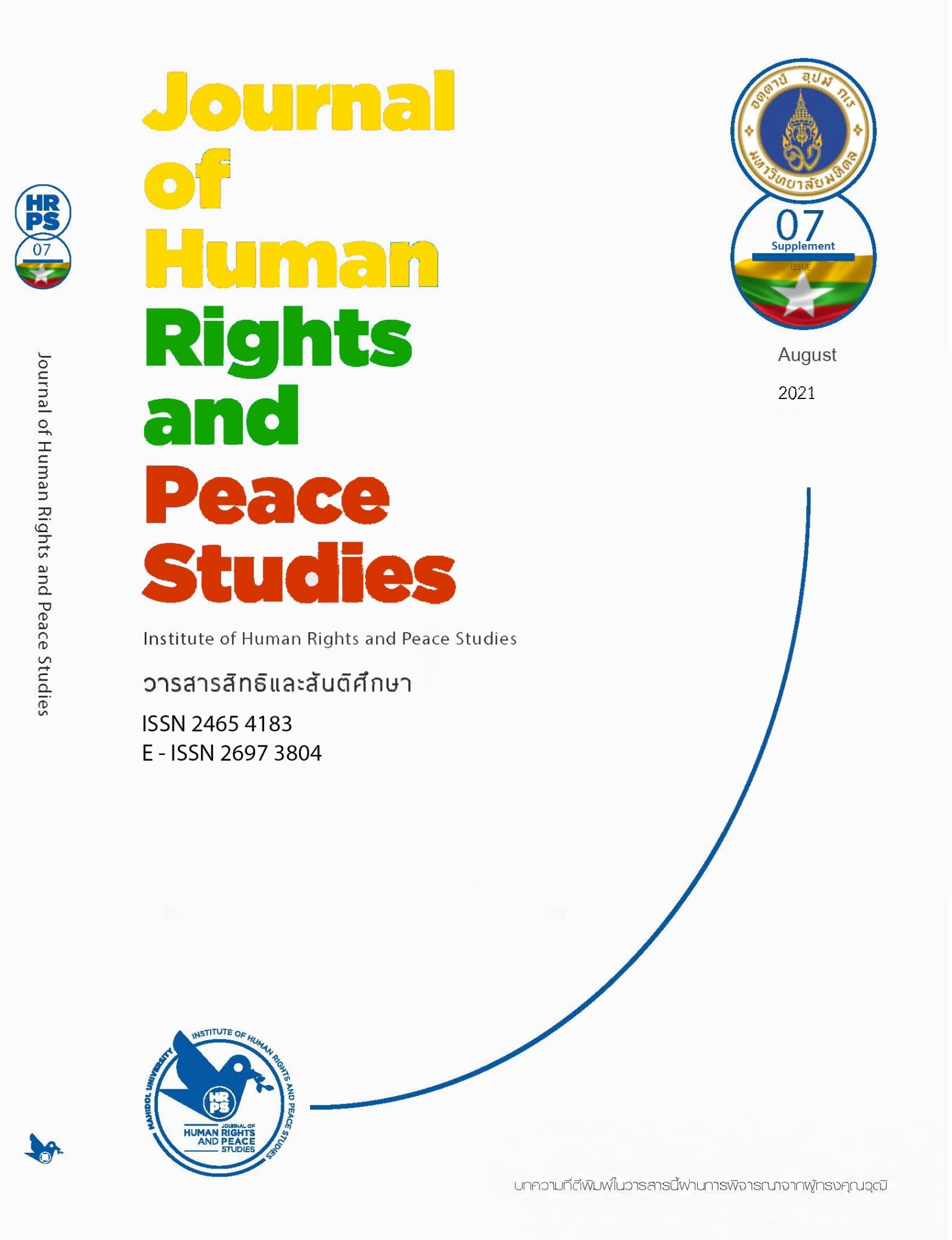Judicial Corruption as a Violation of Human Rights in Myanmar
Main Article Content
Abstract
Corruption is a global problem which occurs in every society and its causes, forms and impacts are diverse and multi-faceted. The government, its officials and agents including all individuals are accountable under the law. Although the Myanmar government has acknowledged and tried to build a just and fair government, many people in Myanmar have experienced an incident of bribery or other form of corruption in the judicial sector. Justice should be administered by a competent, impartial and independent judicial institutions. Corruption is not an isolated crime. In the judicial sector, the corrupt conduct of all judicial actors has directly damaged the consequences on the functions of judicial institution. It decreases public trust in justice and affects judicial systems to guarantee the protection of human rights. Society accepts that when there is corruption, human rights disappear. Violated rights vary from one another by a different way of corrupt conduct. Common violated rights include equality before the law and fair trial rights, especially, judicial independence and impartiality. To prevent corruption in every sector including the judicial sector, the government of Myanmar is taking action upon the corruption not only by Anti-Corruption Law but also other related laws. However, some of these cases can be taken action and judicial corruption still exists in the country. Therefore, it is important to identify the impact and consequences of judicial corruption. The purpose of the paper is seeking to contribute to strengthening the judicial system as well as ensure an adequate accountability mechanism.
Article Details

This work is licensed under a Creative Commons Attribution-NonCommercial-NoDerivatives 4.0 International License.
The views, opinions, and pictures expressed in this journal are those of the authors and do not necessarily reflect the opinions and viewpoints of the editor and the editorial board. All rights are reserved by the authors and the Institute of Human Rights and Peace Studies of Mahidol University. No part of this journal may be reproduced, stored in a retrieval system, or transmitted in any form or by any means without the prior permission in writing from the journal’s editor, or as expressly permitted by law, or under terms agreed with the appropriate reprographics rights organization. Non-commercial use of information in this journal must be properly referenced.
References
th Amendment of Anti-Corruption Law. (Myanmar). (2018). Pyidaungsu Hluttaw law No. 20/2018. https://www.mlis.gov.mm
Annual Report of the Supreme Court of Union of Myanmar. (Myanmar). (2019). http://www.unionsupremecourt.gov.mm.
Anti-Corruption Commission Annual Report. (Myanmar). (2018).
Anti-Corruption Commission Annual Report. (Myanmar). (2019).
Anti-Corruption Commission v. Daw Yi Yi Mon, Daw Zar Chi Win and U Ye Wana. (Myanmar). (2020) Case No.319/17
Anti-Corruption Law. (Myanmar). (2013). Pyidaungsu Hluttaw law No. 23/2013. https://www.mlis.gov.mm
Bak, M. (2019). Overview of corruption and anti-corruption in Myanmar. Transparency International. http://www.jstor.com/stable/resrep20600
Civil Service Personnel Law. (Myanmar). (2013). The Pyidaungsu Hluttaw Law No.5/2013. https://www.mlis.gov.mm
Code of Judicial Ethics. (Myanmar). (2017). http://www.myanmar-law-library.org/law-library/legal-journal/judicial-journal/code-of-judicial-ethics-for-myanmar-judges.html
Constitution of the Republic of the Union of Myanmar. (Myanmar). (2008). https://www.myanmar-law-library.org
Dimant, E., & Tosato, G. (2018). Causes and effects of corruption: What has past decade's empirical research taught us? A survey. Journal of Economic Survey, 32(2), 335-356. https://doi.org/10.1111/joes.12198
Ferguson, G. (2018). Global corruption: Law, theory and practice (3rd ed.). University of Victoria.
Guidelines for Acceptance of Gifts. (Myanmar). (2016).
International Bar Association. (2016). Judicial integrity initiative: Judicial system and corruption. https://baselgovernance.org/sites/default/files/2019-01/the_judicial_integrity_initiative_may_2016_full.pdf
International Council on Human Rights Policy. (2009). Corruption and human rights: Making the connection. ICHRP. https://papers.ssrn.com/sol3/papers.cfm?abstract_id=1551 222.
Justice Base. (2017). Monitoring in Myanmar: An analysis of Myanmar’s compliance with fair trial rights. Myanmar. https://www.myjusticemyanmar.org/sites/default/files/Justice-Base-Monitoring-in-Myanmar-An-Analysis-of-Myanmars-Compliance-with-Fair-Trial-Rights-ENG.pdf
Lin, Z. M. (2019, June 5). Corruption: A severe, chronic disease Myanmar has to fight. Tea Circle. https://teacircleoxford.com/essay/corruption-a-severe-chronic-disease-mya nmar-has-to-fight/
Myanmar National Human Rights Commission Annual Report. (Myanmar). (2016-17).
Myanmar Sustainable Development Plan 2018-2030. Ministry of Planning and Finance. (Myanmar). (2018). https://themimu.info/sites/themimu.info/files/documents/Core _Doc_Myanmar_Sustainable_Development_Plan_2018_-_2030_Aug2018.pdf
PenalCode.(Myanmar).(1861).https://www.ilo.org/dyn/natlex/natlex4.detail?p_lang=en&p_isn=61342&p_country=MMR&p_count=110
Peters, A. (2015). Corruption and human rights. Basel Institute on Governance. https://www.mpil.de/files/pdf4/Peters_Corruption_and_Human_Rights20151.pdf
Peters, A. (2018). Corruption as a violation of international human rights. European Journal of International Law, 29(4), 1251–1287. https://doi.org/10.1093/ejil/chy070
Saw, K. S. (2015). Tackling Myanmar’s corruption challenge. Focus Asia Perspective & Analysis, 13, 1-9. https://www.files.ethz.ch/isn/190805/2015-khaing-corruption-myanmar.pdf
Schultz, J. (2009). The UNCAC and judiciary corruption: Requirements and avenues for reform. Anti-Corruption Resource Center, Chr. Michelsen Institute. https://www.u4.no/publications/the-uncac-and-judicial-corruption-requirements-and-avenues-for-reform
Statement of Myanmar National Human Rights Commission No. 9/2018. (Myanmar). (2018).
Transparency International. (2007). Combating corruption in judicial systems advocacy toolkit. http//www.transparency.org/policy research/surveys indices/cpi/2007.
Transparency International. (2019). Corruption perceptions index. https://www.transparency. org/cpi/2019
U Soe Than v. U Than Zaw. (Myanmar). (2016). Criminal Case No 1/2016, High Court of Mon State.https://www.accm.gov.mm/acc/index.php?route=cms/article&path=49&article_id=120U Thant Zin Oo v. Than Htut Aung and 2
Others. (Myanmar). (2018). Criminal Case No 340/2018, Yangon East District Court. https://www.accm.gov.mm/acc/ index.php?route=cms/article&path=49&article_id=431
Union Judiciary Law. (Myanmar). (2010). The State Peace and Development Council law No. 20/2010. https://www.mlis.gov.mm
United Nations Development Programme & Union Attorney General's Office. (2018). Fair trial guidebook for law officers. UNDP & UAGO.
United Nations General Assembly. (1948, December 10). Universal Declaration of Human Rights (217 A (III)). https://www.ohchr.org/EN/UDHR/Documents/UDHR_Translations /eng.pdf
United Nations International Covenant on Civil and Political Rights. (2007, August 23). General comment no. 32, Article 14, Right to equality before courts and tribunals and to fair trial (CCPR/C/GC/32). https://www.refworld.org/docid/478b2b2f2.html
United Nations Office of the High Commissioner for Human Rights. (1976, January 3). International Covenant on Economic, Social and Cultural Rights: Adopted and opened for signature, ratification and accession by General Assembly resolution 2200A (XXI) of 16 December 1966 entry into force 3 January 1976, in accordance with article 27. https://www.ohchr.org/Documents/ProfessionalInterest/cescr.pdf
United Nations Office on Drugs and Crime. (2005, December, 14). United Nations Convention against Corruption: Adopted and opened for signature, ratification, and accession by General Assembly resolution 58/4 of 31 October 2003 enter into force on 14 December 2005, in accordance with Article 68 (1). https://www.unodc.org /unodc/en/corruption/uncac.html
United States Agency International Development. (2009). Reducing corruption in judiciary: Office of democracy and governance USAID programme brief. https://pdf.usaid.gov/pdf_docs/Pnadq106.pdf


